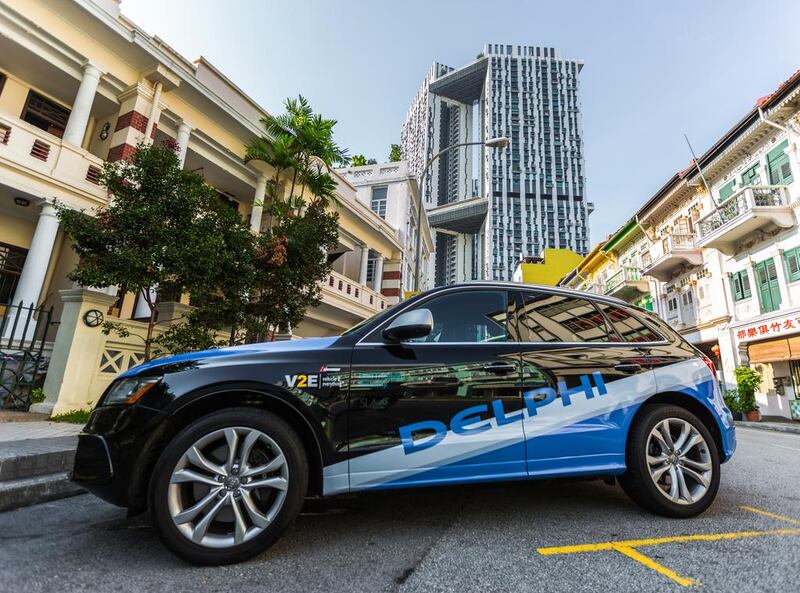The 1990 sci-fi classic film Total Recall featured an early vision of autonomous driving – Arnold Schwarzenegger’s character losing his temper with the robot at the wheel of his Johnny Cab.
Some 26 years later life is now imitating art – but without the roadrage.
Dubai is today hosting the 2nd International Conference on Future Mobility, looking at driverless transport potential among other things, while in Singapore, the South East Asian city’s transport authority has already signed up the UK-headquartered automotive technology company Delphi to pilot a fleet of driverless taxis.
Although still in testing, the cloud-based system is designed to usher in a new era of personal transport via everyday technology such as smartphones.
“We recently launched an automated mobility on demand system in partnership with the government of Singapore,” Serge Lambermont, the technical director for automated driving at Delphi, tells The National.
“What does that mean? Imagine just pulling out your phone, open an app and a driverless car picks you up – anytime, anywhere. This will truly connect passengers to the vehicle’s extended ecosystem and the vehicle to the internet,” he says.
“What’s really cool about this [is] we are building the ecosystem, the foundation upon which anyone can build. This will enable a new level of on-demand, personalised services.”
But while there is much enthusiasm, the reality of ubiquitous driverless cars is a long way off, Tarik Taman, the Dubai-based general manager for India, Middle East & Africa at the software company Infor, tells The National.
According to the Boston Consulting Group, autonomous and semi-autonomous cars are expected to represent 13 per cent of new car sales globally in 2025 and around 25 per cent in 2035.
“Although use of fully autonomous cars – defined by the NHTSA [the US National Highway Traffic Safety Administration] as ‘level 5’ on a scale of zero to five – has already begun in some urban areas, [for example] Uber’s use of autonomous Volvo XC90s in Pittsburgh, widespread use of fully autonomous cars is probably decades away,” Mr Taman says.
Mr Lambermont acknowledges mass use of totally driverless cars “will not happen overnight”.
“In the next several years the reality is that it will be the pieces of automation or the pieces of active safety – rather than full automation – that come to the market and make a big difference,” he says.
“Delphi expects to have a complete turnkey solution to move goods or people in driverless vehicles by 2022. This is where the general public will first experience autonomous driving. It will start in a small controlled manner, from small pilots, then to a fleet, and finally a broader application.
“In Singapore the pilot will be operational in the 2022 time frame. As the service matures, the Singapore fleet will gradually grow up to several hundreds of vehicles,” he says.
But there are significant hurdles to overcome before the driverless revolution can gain widespread traction. “Transportation infrastructure and technology will need to be adapted,” says Mr Lambermont. “The Singapore ‘first mile, last mile’ pilot is a good example. The consumers will want a seamless connection from their train or subway to the automated mobility on demand vehicle. This requires development of the physical and digital infrastructure as, for example, the pick-up and drop-off road segments, and addition of communication with traffic lights, as well as a digital ecosystem to support the bookings, billings and city transport planning.”
In the Middle East, the infrastructure challenges may be easier to overcome, he says, and the development of smart cities, such as Masdar in Abu Dhabi, also provide opportunities.
“The Middle East is a very interesting market for Automated Mobility on Demand since the road infrastructure is easier to adapt, and the governments are very focused on developing new smart cities. Automated Mobility on Demand is an essential part of the new smart city digital ecosystem, and supports the new mobility concepts for people, but also logistics.
“Our system is designed to interface with new smart city ecosystem providers. The technology … can be implemented on passenger vehicles, buses, trucks and future logistic vehicles. These systems will emerge in new innovative cities all over the world.”
It is a vision not lost on the UAE. “Given that the UAE Government has announced that 25 per cent of all public transport systems in the country will be smart and automated by 2030, we are set to see a transformation in the way people and goods move around the country,” says Abdulla Al Maeeni, the director general of Emirates Authority for Standardisation and Metrology.
“The second International Conference on Future Mobility, with its focus on alternative technologies, automation and connected transport, is especially relevant here.”
Delphi says its cloud software will form the heart of its push to automate transport. “The Delphi mobility cloud can interface with ecosystem providers in logistics, and some of the vehicles could use UAE technologies and designs,” Mr Lambermont says.
But there are public perception challenges to be tackled, too. In May, Google posted job listings for test drivers in Arizona, which tech bloggers painted as a dream job. But the social media reaction was a glimpse into the public’s fears of robot cars. “You’re gonna have to pay more to get me in that tin can with a mind of its own,” wrote one Facebook commenter.
Alongside sociological concerns, there are technological issues to be dealt with also, says Mr Taman. “The current limitations of today’s cameras, radar and sensors means that a vehicle can fail to detect objects under certain conditions and if a driver is not prepared to take over control immediately, bad things can happen, as seen in the recent crashes of Tesla Model S vehicles being operated in ‘autopilot’ mode.
“This presents a public perception problem because the primary selling point of an autonomous vehicle is that the driver shouldn’t have to be fully engaged. Put another way, if the driver has to have both hands on the wheel and be prepared to take over control of the vehicle in a split second, they might as well be driving a non- or semi-autonomous vehicle.”
But perhaps one way public concern could be assuaged is the promise that driverless cars will, eventually, make road transport much safer.
Mr Lambermont says the widespread adoption of autonomous vehicles could save millions of lives. “There are more than 1.2 million deaths on roads in the world each year. Ninety to 95 per cent of accidents are due to human error. By 2030, newer automatic vehicles should prevent 90 per cent of cases of people being killed or seriously injured on the road. Which means driverless cars are poised to save 10 million lives per decade,” he says.
Delphi is backing its belief in driverless vehicles with significant investment.
Mr Lambermont says the company “has a strong commitment to research and development”, with R&D making up the equivalent of 10 per cent of global sales annually. The company posted US$4.1 billion in revenue for the third quarter, up 13 per cent year on year, and $531m in adjusted operating profit, up from $470m a year earlier.
“Global expenditure/investment, including engineering, stood at $1.5bn in 2015,” he says, adding: “We have 19,000 scientists, engineers and technicians and 15 major technical centres around the world.”
However, Infor’s Mr Taman points out that that is a significant outlay for what at least initially will be small reward. “The market for driverless – ie level 5, fully autonomous vehicles – will remain a very small percentage, 1 to 2 per cent of total vehicle sales through 2025, with the overwhelming majority of these vehicles used for commercial use in controlled environments. The remaining autonomous vehicle sales will be for ride-hailing service fleets.”
Still, Mr Lambermont is confident his company is on the right road. “Delphi is developing technologies that safely enable a consumer’s digital lifestyle in a connected vehicle,” he says.
“Delphi will provide the hardware, software and services that will enable companies and service providers to move goods and people in a vastly different way than today. Drivers will be connected without noticing it, like electricity today.
“With the advent of autonomous driving, the possibilities are endless.”
chnelson@thenational.ae
Follow The National's Business section on Twitter





